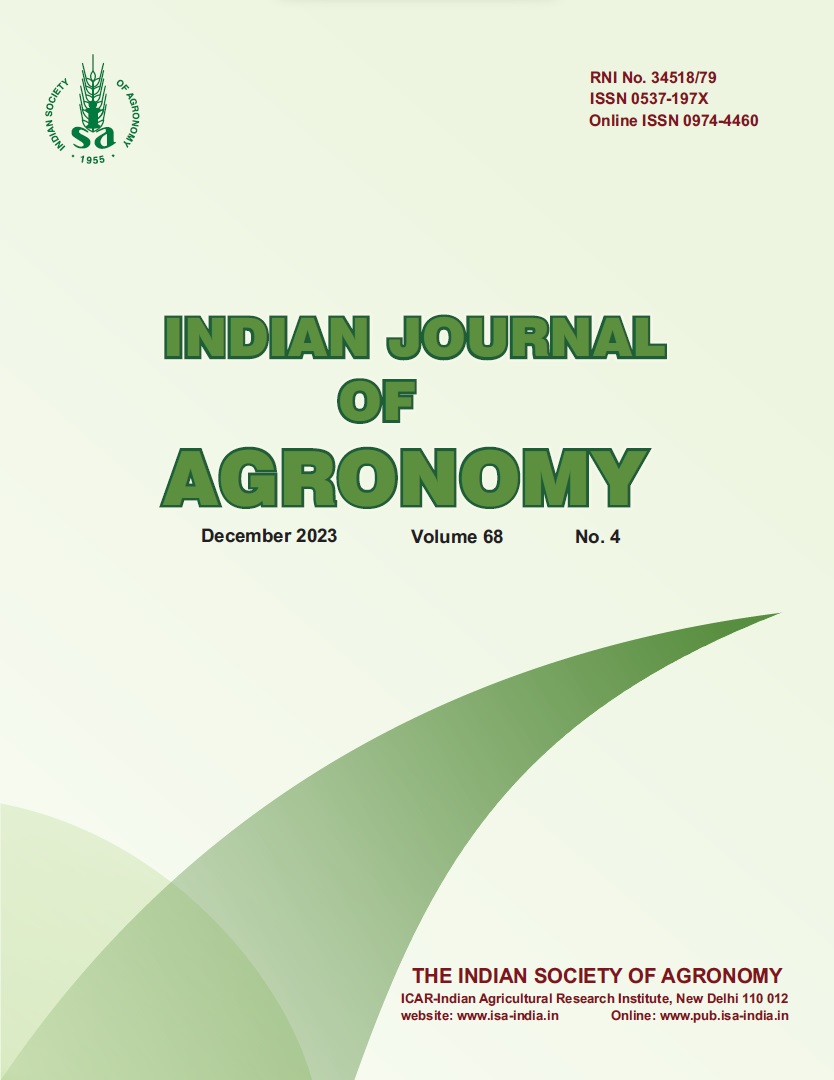Effect of 2, 4-D sodium salt on weeds, growth and yields in rabi maize (Zea mays L.)
DOI:
https://doi.org/10.59797/ija.v68i4.5466Keywords:
2, 4-D, Economics, Grain and stover yields, Weed-control efficiency, Weed indexAbstract
A field investigation was conducted during winter (rabi) season of 2021 at Agricultural Research Farm of Institute of Agricultural Sciences, Banaras Hindu University, Varanasi, Uttar Pradesh, to study the efficacy of doses of 2, 4-D sodium salt 80% WP on weeds, productivity and economics of rabi maize (Zea mays L.). Application of 2, 4- D sodium salt 80% WP @ 1,250 g/ha at 25 days after sowing (DAS) resulted in to lesser weed density and weed dry weight of Physalis minima Roem. & Schult, Chenopodium album (L.), Melilotus indicus (L.) and Cichorium intybus (L.) as compared to 2, 4-D sodium salt 80% WP @ 1,000 g/ha and 2, 4-D sodium salt 80% WP @ 750 g/ha at 60 DAS, with higher weed control efficiency (77.3 %) and lesser weed index (34.9 %). At 60 DAS, 2, 4-D sodium salt 80% WP (applied @1250 g/ha at 25 DAS) produced higher plant height, number of leaves, chlorophyll content, leaf area index and plant dry-matter over other treatments except weed free and two hand weeding at 20 and 40 DAS. Application of 2, 4-D sodium salt 80% WP @ 1,250 g/ha at 25 DAS recorded higher number of cobs, number of kernels, number of kernels/row and seed index as compared to 2, 4-D sodium salt 80% WP @ 1,000 g/ha, and 2, 4-D sodium salt 80% WP @ 750 g/ha. Higher kernel (3.7 t/ha) and stover yield (4.7 t/ha) of maize was recorded due to application of 2, 4-D sodium salt 80% WP @ 1,250 g/ha at 25 DAS with higher harvest index (44.5%) and monetary returns (62.5 × 103 `/ha) as compared to 2, 4-D sodium salt 80% WP @ 1,000 g/ha, and 2, 4-D sodium salt 80% WP @ 750 g/ha.References
Anonymous, 2020. Agricultural statistical data, Department of Agriculture and Cooperation, Ministry of Agriculture and Farmers Welfare, Government of India.
Gomez, K.A. and Gomez, A.A. 1984. Statistical Procedures for Agricultural Research. John Wiley & Sons.
Joshi, N. Singh, V.P., Galav, A., Sharma, S., Dhakar, R. and Meena, R. 2018. Bio-efficacy of various doses of 2, 4-D Ethyl ester 80% EC on weed growth, crop yield of maize and the residual effect on succeeding pea crop. International Journal of Advanced Scientific Research and Management, Special Issue 1(3): 7–8.
Mandi, S., Mandal, B., Krishna, S.K. and Reddy, D.D. 2019. Effect of integrated weed management on weed growth and yield of winter maize (Zea mays). Indian Journal of Agronomy 64(3): 373–377.
Pasha, M.L., Bhadru, D., Krishna, L. and Naik, R.B.M. 2012. Evaluation of different herbicides in zero tillage maize. Madras Agricultural Journal 99(7–9): 471–472.
Raghuwanshi, M., Jha, A.K., Verma, B., Yadav, P.S., and Shrivastava, A. 2023. Weed dynamics of fodder maize as influenced by different herbicides. International Journal of Environment and Climate Change 13(7): 245–251.
Sairam, G., Jha, A.K., Verma, B., Porwal, M., Dubey, A., and Meshram, R.K. 2023a. Effect of mesotrione 40% SC on weed growth, yield and economics of maize (Zea mays L.). International Journal of Environment and Climate Change 13(7): 608–616.
Sairam, G., Jha, A.K., Verma, B., Porwal, M., Sahu, M.P. and Meshram, R.K. 2023b. Effect of pre and post-emergence herbicides on weed flora of maize. International Journal of Plant & Soil Science 35(11): 68–76.
Sanodiya, P., Jha, A.K. and Shrivastava, A. 2013. Effect of integrated weed management on seed yield of fodder maize. Indian Journal of Weed Science 45(3): 214–216.
Sarangi, S.K., Singh, S., Srivastava, A.K., Choudhary, M., Mandal, U.K., Lama, T.D., Mahanta, K.K., Kumar, V., Sharma, P.C. and Ismail, A.M. 2020. Crop and residue management improves productivity and profitability of rice–maize system in salt-affected rainfed lowlands of East India. Agronomy 10(12): 2019. https://doi.org/10.3390/agronomy 10122019
Sinodiya P, and Jha A.K. 2014. Effect of weed management control practices on nutrient uptake and soil properties in fodder maize. JNKVV Research Journal 48(1): 60–63.
Triveni, U., Sandhya, R.Y., Patro, T.S.K. and Divya, M. 2017. Weed management in maize with different pre and post emergence herbicides. Journal of Experimental Biology and Agricultural Sciences 5(1): 54–58.






